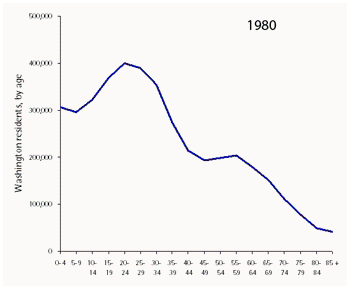The number of babies born in Washington State has barely budged for the last 15 years. But if I had to guess, I’d say we’re going to see a slight rise in the number of newborns in the next few years.
The cause isn’t rising fertility rates, but quirks of the population structure: the grandchildren of the baby boomers are ready to come online.
The animated chart below should make the point. The horizontal axis shows 5-year age groups; the height of the blue line shows how many Washington residents were in that age group in any year. The big hump in the middle represents the baby boomers. Over time, you see a second, smaller bump emerge on the left-side of the graph—the echo boomers, who are just now entering their most fertile years.
Just wait a bit for it to cycle through if you miss it the first time.
[Update: Some people are having problems seeing the animated .gif image below. Try clicking on the “more” link below. ]
[If you still can’t see the moving chart, it may be that you’ve disabled .gif animations on your web browser. Feel free to let us know in comments—we’ll see if we have any suggestions. Thanks!]
Notice that, from about 1990 to today, the number of little kids barely budges, but most other age groups get more numerous. During much of that period, the “baby bust” generation that followed the boomers was in their reproductive peak. But now that the children of the boomers—the “echo boomers”—are entering their twenties, we should start seeing a slight uptick in births, followed by higher school enrollments. Sort of an echo of the echo boom.
Also note that seniors—particularly people over 85—are a particularly fast-growing group. That will only accelerate as the boomers retire.
It’ll be interesting to see how these demographic shifts will play out in the housing market. We may be entering a time when boomers will be looking to downsize at just the same time that their kids are looking to start new families. Will that mean more pressure for low-density suburban housing? Less? Just the same? I suppose we’ll have to wait and see.



